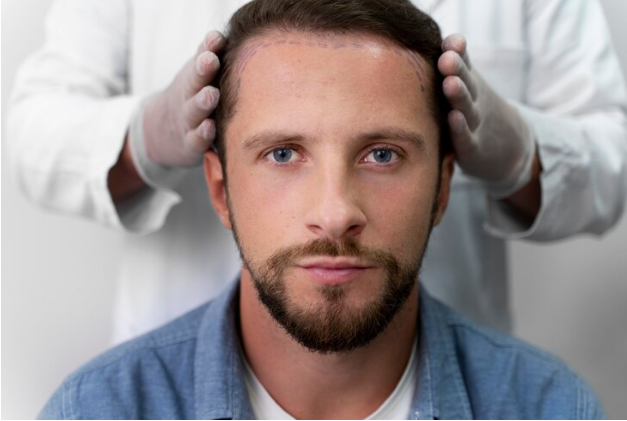
Hairline Lowering
No matter if you’re a man or woman with a high hairline that affects your facial symmetry and overall ease, this article can guide you in achieving a more youthful and naturally balanced hairline.
Hair transplant for hairline lowering, also known as forehead reduction, is a minimally invasive surgery used to lower the hairline for individuals with a naturally high hairline or those experiencing hairline recession, such as in male pattern baldness. The procedure involves surgically adjusting the hairline to bring it closer to the eyebrows, balancing facial proportions and significantly enhancing the patient’s appearance.
Typically performed under local anesthesia, the procedure takes about 5-6 hours. The surgeon creates slits along the existing hairline and implants harvested hair follicles into these pre-made incisions using forceps. The result is a new hairline with a relatively smaller forehead.
Advantages of Hair Transplant for Hairline Lowering
Undergoing a hairline lowering hair transplant offers several benefits. For individuals with a broad forehead, it helps balance facial proportions, enhancing facial symmetry. A high or receding hairline can make the forehead appear disproportionately large, affecting the overall balance and harmony of facial features. By lowering the hairline, the forehead is made relatively smaller, creating a more balanced and harmonious facial appearance.
Secondly, it can significantly improve self-confidence. Hair loss and a receding hairline can be sources of insecurity for many individuals. By lowering the hairline and filling in balding areas, individuals can regain their confidence and feel better about their appearance.
Hair Transplant Techniques for Hairline Lowering
There are two main types of hair transplant techniques: Follicular Unit Transplantation (FUT) and Follicular Unit Extraction (FUE).
However, surgeons have identified the limitations of traditional hair transplant techniques and have made further refinements.
Both procedures have their advantages and considerations, with the choice often depending on the individual’s specific needs and the surgeon’s recommendation.
Over the past decade, the FUE technique has been refined by expert hair transplant surgeons at Dr. Haror’s Wellness, introducing a technique of Ultra Receptive FUE. The advancement, combined with extensive experience, proper techniques, and the latest tools, is aimed at delivering finer surgical execution and more predictable hair transplant results.
Challenges in Hair Transplant
While hair transplantation, in general, is a smooth surgical execution, it poses challenges in candidates with advanced baldness and compromised donor areas. The surgical execution requires a methodology to meet these challenges. Achieving a near-to-natural look is a demand that only an expert hand can ensure.
The hairline needs to be planned with a near-to-natural look with the right temporal angulation in a zig-zag pattern. Dr. Haror’s Wellness often comes across cases with young men with advanced baldness of grade V-VII, presenting an interesting yet challenging opportunity to meet their expectations and deliver results without imperfection.
Cost of Hair Transplant in Delhi
New Delhi, the capital of India, has become a preferred destination for hair transplant due to its combination of high-quality services, experienced surgeons, and affordable prices. The country’s medical tourism industry is well-regulated, ensuring that clinics adhere to strict standards of safety and quality.
The key advantage of having a hair transplant in Delhi is the cost. Prices are significantly lower than in countries like the United States and Europe, even when considering travel and accommodation expenses. This affordability doesn’t compromise the quality of care, as clinics use the latest technology and hair transplant techniques.
Selecting the Right Hair Transplant Center in Delhi
A deciding factor for choosing a clinic in New Delhi, it’s crucial to conduct in-depth research. Seek out establishments with a solid reputation, favorable feedback from patients, and skilled practitioners.
Prioritize clinics that prioritize patient-centric approaches and maintain a professional standard in post-operative care. Reputable clinics provide extensive consultations, tailor-made treatment plans, and ongoing support. Furthermore, they should be forthcoming about procedure costs and potential risks, ensuring transparency throughout the entire process.





